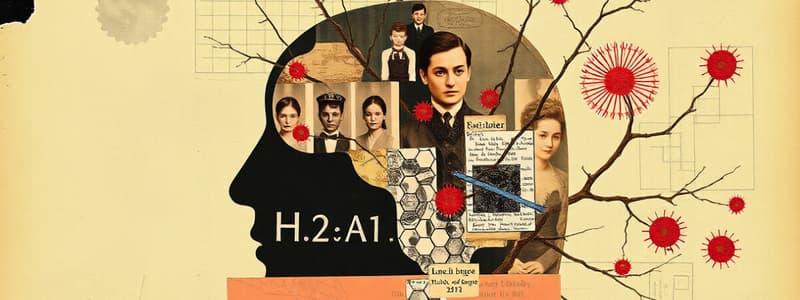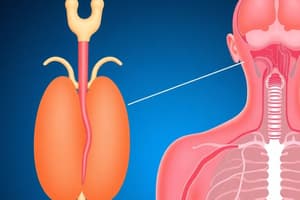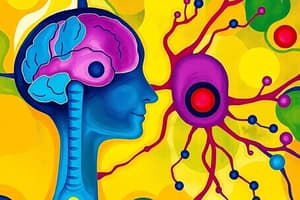Podcast
Questions and Answers
What is the primary function of hormones produced by endocrine glands?
What is the primary function of hormones produced by endocrine glands?
- They are secreted only in response to external stimuli.
- They transmit signals instantly within the nervous system.
- They influence local cells through direct synaptic transmission.
- They enter circulation and affect distant cells with specific receptors. (correct)
Which of the following statements accurately contrasts nervous and endocrine communication?
Which of the following statements accurately contrasts nervous and endocrine communication?
- Nervous signals travel faster than endocrine signals through blood.
- Endocrine responses occur instantly, while nervous responses are delayed.
- Endocrine signals can have a longer duration of response compared to nervous signals. (correct)
- Nervous communication is unidirectional, whereas endocrine communication is consistent across distances.
What role do pheromones play in communication between individuals of the same species?
What role do pheromones play in communication between individuals of the same species?
- They induce hormonal changes within the individual.
- They only affect individuals in response to stress.
- They act as neurotransmitters in synaptic communication.
- They influence the behavior of the opposite sex. (correct)
Which statement correctly defines the mode of transport in the nervous system?
Which statement correctly defines the mode of transport in the nervous system?
Which of the following substances serves as a common messenger in both nervous and endocrine systems?
Which of the following substances serves as a common messenger in both nervous and endocrine systems?
Which signaling mechanism involves effects on the same cell type from which signals are released?
Which signaling mechanism involves effects on the same cell type from which signals are released?
What is a characteristic of paracrine signaling compared to endocrine signaling?
What is a characteristic of paracrine signaling compared to endocrine signaling?
Which of the following is an example of a substance involved in autocrine signaling?
Which of the following is an example of a substance involved in autocrine signaling?
What type of cells primarily utilize neurotransmitters for communication?
What type of cells primarily utilize neurotransmitters for communication?
Endocrine signaling is characterized by which of the following?
Endocrine signaling is characterized by which of the following?
Which communication mechanism is likely to inactivate signals quickly after release?
Which communication mechanism is likely to inactivate signals quickly after release?
What is the main purpose of intercellular communication mechanisms in multicellular organisms?
What is the main purpose of intercellular communication mechanisms in multicellular organisms?
What type of signaling would involve cytokines as a key mediating substance?
What type of signaling would involve cytokines as a key mediating substance?
Which of the following correctly describes the function of an agonist?
Which of the following correctly describes the function of an agonist?
Which of the following scenarios describes the use of an antagonist?
Which of the following scenarios describes the use of an antagonist?
What is the role of muscarinic receptors in the autonomic nervous system?
What is the role of muscarinic receptors in the autonomic nervous system?
How does curare act at the neuromuscular junction?
How does curare act at the neuromuscular junction?
Which of the following compounds is an agonist that can trigger mucus secretion?
Which of the following compounds is an agonist that can trigger mucus secretion?
What is the primary role of free hormone in the body?
What is the primary role of free hormone in the body?
Which statement best describes bound hormone?
Which statement best describes bound hormone?
What defines the characteristic rates of hormone degradation and elimination?
What defines the characteristic rates of hormone degradation and elimination?
In hormonal signaling, permissiveness refers to which of the following?
In hormonal signaling, permissiveness refers to which of the following?
Which mechanism primarily regulates the synthesis and secretion of hormones?
Which mechanism primarily regulates the synthesis and secretion of hormones?
What occurs during hormone synergism?
What occurs during hormone synergism?
How do humoral stimuli influence insulin secretion?
How do humoral stimuli influence insulin secretion?
What is the effect of negative feedback in hormone regulation?
What is the effect of negative feedback in hormone regulation?
Flashcards
Hormone Action
Hormone Action
Hormones act on distant cells with specific receptors to influence their function.
Neuroendocrine Cells
Neuroendocrine Cells
Specialized cells that produce hormones in response to nervous system signals.
Pheromone
Pheromone
Chemicals secreted in bodily fluids that influence the behavior of the same species, especially mates.
Nervous & Endocrine Similarities
Nervous & Endocrine Similarities
Signup and view all the flashcards
Nervous & Endocrine Differences
Nervous & Endocrine Differences
Signup and view all the flashcards
Agonist
Agonist
Signup and view all the flashcards
Antagonist
Antagonist
Signup and view all the flashcards
Muscarinic Receptor
Muscarinic Receptor
Signup and view all the flashcards
Nicotinic Receptor
Nicotinic Receptor
Signup and view all the flashcards
What is the difference between an agonist and antagonist?
What is the difference between an agonist and antagonist?
Signup and view all the flashcards
Free Hormone
Free Hormone
Signup and view all the flashcards
Bound Hormone
Bound Hormone
Signup and view all the flashcards
Negative Feedback Loop
Negative Feedback Loop
Signup and view all the flashcards
Positive Feedback Loop
Positive Feedback Loop
Signup and view all the flashcards
Humoral Stimuli
Humoral Stimuli
Signup and view all the flashcards
Neural Stimuli
Neural Stimuli
Signup and view all the flashcards
Hormonal Stimuli
Hormonal Stimuli
Signup and view all the flashcards
Synergism
Synergism
Signup and view all the flashcards
Cell-Cell Communication
Cell-Cell Communication
Signup and view all the flashcards
Major Communication Systems
Major Communication Systems
Signup and view all the flashcards
Autocrine Signaling
Autocrine Signaling
Signup and view all the flashcards
Prostaglandins
Prostaglandins
Signup and view all the flashcards
Paracrine Signaling
Paracrine Signaling
Signup and view all the flashcards
Endocrine Signaling
Endocrine Signaling
Signup and view all the flashcards
Coordinated Function
Coordinated Function
Signup and view all the flashcards
Highly Differentiated Cells
Highly Differentiated Cells
Signup and view all the flashcards
Study Notes
Hypothalamic Hormones and Pituitary Function
- The hypothalamus produces releasing and inhibiting hormones that regulate anterior pituitary hormone secretion.
- Releasing hormones stimulate the release of specific anterior pituitary hormones, while inhibiting hormones decrease their release.
- The anterior pituitary releases hormones that act on various target organs, influencing their function.
Cell-Cell Communication
- Multicellular organisms require extensive signalling mechanisms to coordinate cellular behavior across the body.
- Specialized cells have evolved for intercellular communication, particularly over long distances.
Major Communication Systems
- The nervous, endocrine, and immune systems work together to coordinate cellular activity and response to inner/outer environment changes.
- Neurotransmitters, hormones, and cytokines are principal messengers facilitating communication.
Autocrine Mechanism of Signaling
- Signals are released by cells and act locally on the same cell type.
- These signals are often rapidly inactivated, typically having short-lived effects.
- Prostaglandins are one instance of autocrine signaling.
Prostaglandin Autocrine Control
- Prostaglandins (PGs), particularly PGE2, exert autocrine control in stromal and endothelial cells.
- These signals, mediated by cyclooxygenase (COX-2), promote growth and/or migration.
- Autocrine signalling is involved in diverse biological activities.
Paracrine Mechanism of Communication
- Paracrine signalling involves the release of signals by cells, affecting other nearby cells without entering the bloodstream.
- The mediators act locally, affecting target cells around the releasing cell.
- An illustrative example, is the paracrine regulation in the pancreas, where various cell types interact locally via signals like glucagon, somatostatin, and insulin.
Endocrine Mechanism of Communication
- Hormones are released into the bloodstream, reaching target cells with specific receptors.
- Endocrine glands produce and release hormones into the circulatory system enabling long-distance signalling.
Neuro-Endocrine Mechanism of Communication
- Specialized neuroendocrine cells in the nervous system release hormones into the bloodstream in response to stimuli.
- The hormones subsequently regulate bodily functions and responses.
Pheromones
- Pheromones are chemicals secreted in bodily fluids potentially affecting the behavior of opposite-sex individuals of the same species.
Nervous and Endocrine Communication - Similarities and Differences
- Both systems are interconnected: the hypothalamus is a hub for both systems. Common messengers like epinephrine can act in both capacities.
- Nervous system signaling is rapid (milliseconds). Endocrine signaling is slower (seconds to days). Information transport in nervous system is unidirectional through axons; while in the endocrine system, information is transported via bloodstream or interstitial fluid.
Amplitude vs. Frequency Modulation in Hormone Secretion
- Hormone concentration patterns can vary in the blood over time, and this can convey information.
- The amplitude (magnitude of the hormone peak) of the signal can control the effects on target cells differently in time.
- The consistency (frequency) of the signal is also crucial in the control of target cell behavior.
Controlling Hormone Secretion
- Synthesis and release of hormones is a main regulated aspect of endocrine control.
- Feedback mechanisms, both negative and (less frequently) positive, govern hormone release.
Concentration of Hormone as Seen by Target Cell
- Hormone action depends on its rate of production, delivery, decay, and elimination.
Free Hormone
- The free fraction of hormone is the active portion. The proportion controls feedback inhibition, influences the rate of hormone clearance in the circulation, and mirrors clinical cases of hormone deficits or excess.
Bound Hormone
- Bound hormones, which are connected to plasma proteins, are inactive. The connection increases the circulatory half-life, influencing hormone delivery to receptors.
Synthesis and Secretion of Hormones
- Regulation of hormone synthesis and secretion is a key aspect of endocrine control.
- Negative and, less commonly, positive feedback loops are mechanisms regulating these processes.
Negative Feedback Loops (Illustrative Example)
- In the hypothalamic-pituitary-thyroid axis, the hypothalamus releases TRH, which stimulates the pituitary to secrete TSH. TSH stimulates the thyroid to release T4 and T3. High levels of T4 and T3, in turn, inhibit the release of TRH and TSH in a negative feedback loop.
Positive Feedback Loops (Illustrative Example)
- Oxytocin release during labor is an example of positive feedback. Uterine contractions stimulate oxytocin release, augmenting contractions and accelerating the process until labor is complete.
Humoral Stimuli - Blood Chemistry
- Blood levels of various substances, such as calcium, can directly influence hormone release through receptor binding.
Humoral Stimuli - Glucose and Insulin
- Glucose concentrations in the bloodstream stimulate insulin release from pancreatic beta cells.
Neural Stimuli (Control)
- Neural stimuli influence endocrine cells via neurotransmitters released from neurons. Stimulatory neurotransmitters increase hormone secretion, whereas inhibitory neurotransmitters decrease secretion.
Control by Hormonal Stimuli (Illustrative Example)
- Hormone release is often controlled by other hormones. These hormones can stimulate or inhibit release.
Hormone Interaction
- Hormones can act synergistically (amplifying effects) or permissively (when one hormone is essential for another's action).
- Hormones can also act antagonistically by inhibiting each other’s effects.
Agonists and Antagonists (Mechanism)
- Agonists mimic the effects of natural hormones. Antagonists block hormone effects or receptor binding.
Agonists (Illustrative Example)
- Adrenaline is a natural hormone. Its analogue, phenylephrine, can mimic its effects (e.g., in constricting nasal mucus secretions).
Antagonists (Illustrative Example & Use)
- Antagonists are used in relation to medical treatments for conditions mediated by hormonal imbalances. For example, certain antagonists are used to treat prostate cancer by inhibiting androgen receptors.
Receptors
- Different types of hormone receptors exist, including muscarinic receptors for acetylcholine in the autonomic nervous system, and nicotinic receptors at neuromuscular junctions.
- Receptor binding by hormones leads to either stimulation or inhibition of the target cells' response.
Studying That Suits You
Use AI to generate personalized quizzes and flashcards to suit your learning preferences.




